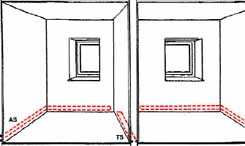
wall heating
Mold assessors know the problem. When steam condensate is reflected on the cold areas of a room and leads to an increased surface moisture, the wall structure has to be carefully examined. A classic thermal bridge occurs when the surface temperature at certain points of the wall is several degrees Celsius lower than the room air temperature. The first proposal for a fix will be in an improvement of the thermal insulation. Who would conceive, to avoid thermal bridges by a base heater?
The basic idea of the wall heating
Unlike large-scale wall heaters heating by copper pipes are only at specific points of the wall. First, a pipe loop results in the base area along the wall. The rising heat is transferred to the overlying parts of the surface. To perform heat in the room exclusively through this system of base heating are optionally provide further heating loops or involve an additional radiant heaters.
Preferred application in the base area
The most effective application of heating is carried out in the base area. These two heating tubes in the flow and return pipes are either plaster (with wall contact!) or laid under plaster with a plaster thickness of 15 mm plus / minus 5 mm. The tube inside diameter is usually 15 mm, with larger wall lengths 18 mm. As bare copper tubing is used, since in comparison with other materials, the heat transfer is much better. Another benefit is the reduced wall thickness. With careful plastering avoiding cavities no sound problem is to be expected. In order to enable the individual room control, each loop receives a thermostatic valve. Conclusion: Find yourself a competent craftsmen and are the structural conditions allright, the wall heating could be an alternative for interior insulation.
Further Reading
Those who are concerned with wall heating, can not get past Henning Großeschmidt. He is a restorer of Antiquities and operates an office for thermal building physics in Bernried/Germany. Henning Großeschmidt was until 2008 a senior restorer of the regional office of non-state museums in the State Conservation Office in Munich and has developed the base heating about 30 years ago and has since been implemented in many museums. Meanwhile, there is a research project with the base heating. Its technical characteristics and its effects on the indoor climate and building design should be worked scientifically.
http://forschungsprojekt-temperierung.byseum.de/de/home
